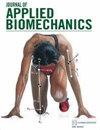模拟低速后碰撞时腰椎运动学和动力学特征。
IF 1.3
4区 医学
Q4 ENGINEERING, BIOMEDICAL
引用次数: 1
摘要
背景最近的研究表明,腰痛是低速碰撞后的常见症状。尽管经常有疼痛报告,但尚未完成涉及人类志愿者的研究,以检查低速后部碰撞过程中腰椎的暴露情况。方法招募了四名参与者,并用一个定制的撞击雪橇模拟后部碰撞,速度变化为8km/h。随机碰撞是在有和没有腰部支撑的情况下完成的。进行了反向动力学分析,并将输出用于生成L4/L5节理压缩和剪切峰值的估计值。结果L4/L5的平均峰值压缩和剪切反作用力(SD)在没有腰部支撑的情况下(压缩=498.22 N[178.0 N];剪切=302.2 N[98.5 N])与有腰部支撑的(压缩=484.5 N[151.1 N];剪切=291.3 N[176.8 N])没有显著差异。峰值剪切时,没有腰部支撑时的腰椎屈曲角度为36°(12°),有腰部支撑时为33°(11°)。结论总体而言,在重复提升过程中,估计的反作用力分别为美国国家职业安全与健康研究所现有压缩和剪切职业接触限值的14%和30%。研究结果还表明,在实验室碰撞模拟过程中,腰部支撑不会显著影响L4/L5关节的总反作用力。本文章由计算机程序翻译,如有差异,请以英文原文为准。
Characterizing Lumbar Spine Kinematics and Kinetics During Simulated Low-Speed Rear Impact Collisions.
BACKGROUND
Recent work has demonstrated that low back pain is a common complaint following low-speed collisions. Despite frequent pain reporting, no studies involving human volunteers have been completed to examine the exposures in the lumbar spine during low-speed rear impact collisions.
METHODS
Twenty-four participants were recruited and a custom-built crash sled simulated rear impact collisions, with a change in velocity of 8 km/h. Randomized collisions were completed with and without lumbar support. Inverse dynamics analyses were conducted, and outputs were used to generate estimates of peak L4/L5 joint compression and shear.
RESULTS
Average (SD) peak L4/L5 compression and shear reaction forces were not significantly different without lumbar support (compression = 498.22 N [178.0 N]; shear = 302.2 N [98.5 N]) compared to with lumbar support (compression = 484.5 N [151.1 N]; shear = 291.3 N [176.8 N]). Lumbar flexion angle at the time of peak shear was 36° (12°) without and 33° (11°) with lumbar support.
CONCLUSION
Overall, the estimated reaction forces were 14% and 30% of existing National Institute of Occupational Safety and Health occupational exposure limits for compression and shear during repeated lifting, respectively. Findings also demonstrate that, during a laboratory collision simulation, lumbar support does not significantly influence the total estimated L4/L5 joint reaction force.
求助全文
通过发布文献求助,成功后即可免费获取论文全文。
去求助
来源期刊

Journal of Applied Biomechanics
医学-工程:生物医学
CiteScore
2.00
自引率
0.00%
发文量
47
审稿时长
6-12 weeks
期刊介绍:
The mission of the Journal of Applied Biomechanics (JAB) is to disseminate the highest quality peer-reviewed studies that utilize biomechanical strategies to advance the study of human movement. Areas of interest include clinical biomechanics, gait and posture mechanics, musculoskeletal and neuromuscular biomechanics, sport mechanics, and biomechanical modeling. Studies of sport performance that explicitly generalize to broader activities, contribute substantially to fundamental understanding of human motion, or are in a sport that enjoys wide participation, are welcome. Also within the scope of JAB are studies using biomechanical strategies to investigate the structure, control, function, and state (health and disease) of animals.
 求助内容:
求助内容: 应助结果提醒方式:
应助结果提醒方式:


